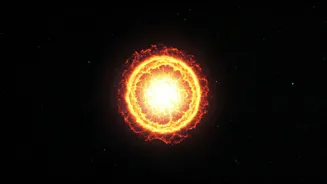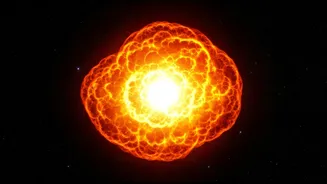Early Supernova Insights
Recent observations of a supernova have unveiled an initial blast that displayed an olive shape. This unprecedented insight into the early phases of a stellar
explosion comes from groundbreaking work by astronomers. They were able to observe the supernova, capturing its first moments. This is crucial as it allows researchers to study the mechanisms involved in these cosmic events. Supernovae are pivotal in the universe because they synthesize heavy elements, distributing them throughout space. Understanding the initial phases sheds light on the overall process of stellar death and the origins of these elements. The olive-shaped blast reveals the asymmetry in the explosion, pointing to the complex processes at play as the star collapses and ejects material. These initial observations are pivotal in understanding the full evolution of a supernova.
The Asymmetric Blast
The asymmetric shape of the supernova's initial blast is a key finding. The olive shape hints at complex internal processes within the dying star. This asymmetry is believed to be caused by various factors, including the star's internal structure, rotation, and magnetic fields. Astronomers utilize sophisticated models to explain how a star, initially spherical, can produce such a blast. These models are constantly refined based on observational data. Studying the blast's asymmetry gives scientists important clues about how the star collapsed and how its material was ejected. The asymmetry's nature suggests that the distribution of elements and the formation of remnants such as neutron stars or black holes are impacted. Further investigations into the supernova's initial blast will offer detailed insights into the dynamics of the explosion.
Groundbreaking Observations
The observations leading to the discovery of the olive-shaped blast represent a significant advancement in observational astronomy. Researchers employed advanced telescopes and data analysis techniques. Their ability to capture and analyze the early moments of a supernova is a major accomplishment. It demonstrates the capabilities of modern telescopes, which can observe the universe with unprecedented detail. Capturing such an event requires careful planning and precise timing, given the transient nature of supernovae. This success showcases the collaboration among astronomers worldwide. The ability to witness these events is transforming our understanding of cosmic phenomena. The data collected will serve as the foundation for further research into the lives and deaths of stars, furthering our knowledge of the universe.
Impact on Astronomy
This discovery holds significant implications for astronomical research. The findings will impact several areas of study. It helps improve our knowledge of stellar evolution and the mechanisms behind supernovae. It is essential in understanding how the universe's chemical composition evolved. Scientists are learning about the synthesis and distribution of heavy elements that are necessary for the formation of stars, planets, and even life. The early observations of the blast will provide crucial information for theoretical models. Astronomers are now able to compare theoretical predictions with actual observations, refining our understanding of the universe. This will encourage future research into supernovae and other astronomical phenomena.














